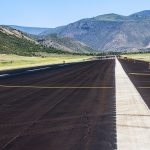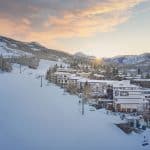Lindsay Cagley: The adaptive leader in Aspen who fights for accessibility

Challenge Aspen/Courtesy photo
Editor’s note: This story is part of a series, in honor of International Women’s Month, that shines a spotlight on the dynamic women of Aspen and the Roaring Fork Valley.
Challenge Aspen Chief Executive Officer Lindsay Cagley understands how important access to the outdoors is for the residents of the Roaring Fork Valley and believes in making it accessible to everyone, regardless of disability or challenges.
“The nature of Colorado and this valley is to be outside as much as possible,” she said. “People here understand what being outdoors means to our physical health, mental health, our community, and our social life. Challenge Aspen wants to make sure that what we know and love about this place is accessible to everybody.”
It was the love of the outdoors that brought the Nashville, Tennessee, native to Colorado 20 years ago, 11 of them spent in the Roaring Fork Valley enjoying everything the region has to offer.
“I’ve been in the ski industry in some way the whole time I’ve been in Colorado,” she said. “When I moved to this valley, I ended up working for Aspen Skiing Company in hospitality, as the director of sales and marketing for the Limelight for a while. I found myself in hospitality as a kind of lifestyle supporter, if you will. I love living here and raising my son here.”

In 2021, Cagley left hospitality to join Challenge Aspen after the former CEO Jeff Hauser announced that he would step down, serving as the first female CEO of the organization in its 28-year history.
The Aspen Times Arts and Entertainment Editor Sarah Girgis chatted with her about her transition from hospitality to Challenge Aspen and why she is passionate about making the outdoors accessible to everyone.
The conversation has been edited for brevity and clarity.
Sarah Girgis: What was the impetus for you to transition from the hospitality industry to running a non-profit like Challenge Aspen?
Lindsay Cagley: I heard that the CEO was retiring and just felt right. This was the job for me 100% even though I had never worked in adaptive sports before. I have a father who’s disabled. My father had a massive stroke the minute I moved to Colorado. So he’s hemiplegic with all sorts of physical and cognitive challenges that he faces every day. He was a sportsman before his stroke. He was a fisherman and a golfer. He loved being outdoors, and that was one of the things that he lost when he had his stroke. In this role, I’ve learned that it’s not because he can’t; it’s because he just doesn’t have access to a place like Challenge Aspen in Tennessee that will take him to go fishing or to go golfing.
SG: What were some of the challenges you faced when first taking the role?
LC: One of the benefits of coming from hospitality is that I had a big, diverse team, learned how to work with many people and support them and remove obstacles. That’s a skill that will take you anywhere. Moving into a non-profit, I did have to learn a lot. I had to learn about fundraising for one. We’re planning our programs before anybody’s given us a dollar. So that takes an amount of bravery on the part of our team, to go out and plan these programs and be out in the community and be prepared to serve you – not knowing how many dollars are going to come in to support those efforts. And so you find yourself doing a lot with a little.

SG: What is the biggest lesson you’ve learned?
LC: I see and understand a lot more than I used to about disability even with a family member who has a disability. Our community wants to serve and help everybody. The challenge is: Are we physically equipped to do so? And so we find ourselves, you know, making adaptations everywhere, which is what we’re good at. Knowing who works, where in our industry, and what type of resources are in hotels here helps me in my role to build partnerships and strategically be able to bring more people here to serve.
SG: What are the biggest misconceptions of people with disabilities?
LC: A common misconception is that people with disabilities are not smart. And that’s a huge blanket statement, right? Ultimately, we have athletes who don’t speak verbally, but they have brilliant minds, and they understand everything that you say. It’s just that they have to communicate differently.
As a resort town, there are a lot of misconceptions about what the needs are of people with disabilities because we’re serving people with all types of disabilities. Of course, we have challenges with physical space. But when we talk about serving athletes with developmental disabilities, visual impairment, or hearing impairment, there are so many other ways to adapt that are almost natural if you’re not focused on the actual disability part.

SG: How can the community get involved?
LC: We have volunteer opportunities year-round, and our volunteers are very dedicated. We do require training to volunteer, and we do background checks because we’re working with a marginalized population that could be taken advantage of. There is some effort to get started and volunteer, but once you do it is the best job that you’ll never get paid for. I would say that our volunteers receive just as much if not more out of the experience as our participants and athletes because it is a joy to be a part of, somebody else’s joyful times being outdoors enjoying nature. So if you want to volunteer doing something you already love — like hiking or skiing, biking, or paddleboarding — this is a place to be able to do that.
SG: What does success look like for you?
LC: At the end of the day, we enjoy seeing people have that light bulb come on that they can do this. That’s just a great feeling, and that inspires us and motivates us to come up with new program ideas. Everybody here just enjoys being a part of whatever small part of someone’s story we can be. We’re happy to do whatever it takes.
Editor’s note: This post has been updated to correct a misspelling of Lindsay Cagley’s name.
Meet the Aspen art connoisseur passionate about female artists
Kim Reichhelm: The extreme skier who wants women to find their stoke
Breeze Richardson: The community engager leading Aspen Public Radio
Susan Wrubel: The aficionado who believes in the unifying power of cinema
Barbara Glass: The Aspen designer with an eye for color and texture
Sarah Girgis is the Publisher for The Aspen Times. She can be reached at 970-429-9151 or sgirgis@aspentimes.com.
Old Snowmass house burns in fire, ‘considered a total loss’
A home in Old Snowmass burned Wednesday night, resulting in a “total loss.”









